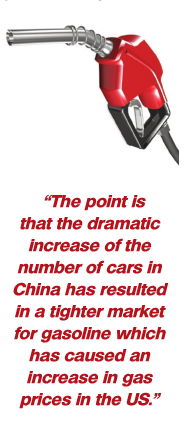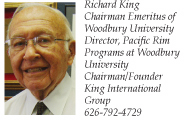By: Richard King

Many of us in the United States are currently complaining about paying close to $5.00 per gallon at the gas pump! We have been spoiled somewhat by the price of gasoline for US drivers being the lowest among industrialized countries. It is not unusual to pay $9 to $10 per gallon in Europe and Japan. As I was filling my tank recently, and paying more than $50.00, I asked myself if my friends in China were experiencing the same situation as they fueled their cars. This prompted me to focus on the subject for this article.
First, let’s look at the supply and demand situation in China. The growth of the Chinese economy at a rate of 9.4% during the past decades and the concurrent economic reforms have caused national income to increase which improved the domestic standard of living and resulted in automobile transportation advancing dramatically. Data from the national Bureau of Statistics in China indicates that the number of automobiles owned in China reached 28 million in 2005 (passenger cars 19 million, trucks 10 million, etc.,) resulting in an  annual average increase of approximately 12%. There were significant increases in the number of owned cars in Beijing 15%; Hebei province 14%; Shanghai 12%; Zhejiang province 18%; Jiangsu province 14% in Guangdong 15%. This increase in the number of privately owned automobiles is coupled with the expansion of the consumption of gasoline and diesel as transportation fuels. Starting in 1990, this growth has really skyrocketed with the demand for gasoline and diesel fuel increasing about 10%. One of the reasons for this significant increase in the consumption of diesel is that the number of trucks owned for transportation increased as a result of construction of national roads and highways and other infrastructure improvements. Also the use of farming equipment contributed to a significant growth in the number of trucks used for farming purposes. annual average increase of approximately 12%. There were significant increases in the number of owned cars in Beijing 15%; Hebei province 14%; Shanghai 12%; Zhejiang province 18%; Jiangsu province 14% in Guangdong 15%. This increase in the number of privately owned automobiles is coupled with the expansion of the consumption of gasoline and diesel as transportation fuels. Starting in 1990, this growth has really skyrocketed with the demand for gasoline and diesel fuel increasing about 10%. One of the reasons for this significant increase in the consumption of diesel is that the number of trucks owned for transportation increased as a result of construction of national roads and highways and other infrastructure improvements. Also the use of farming equipment contributed to a significant growth in the number of trucks used for farming purposes.
Gasoline consumption was greatly influenced by the dramatic growth in passenger vehicles. The smuggling of gasoline became rampant in the 1990’s, particularly in the coastal cities and Guangdong province. This problem forced the Chinese government to declare a ban in gasoline importation in the year 2000.
The demand for new cars in China continues to grow and it is estimated that China has now sold and produced over 150 million cars. It is important to note that these cars are not replacing scrapped vehicles but are for new drivers who are buying their first gallon of gas. During this same period, US automobile production declined, but the price of gas in the US continued to increase. Beginning in the year 2000, China started producing 2 million cars and the price of gas in the US was approximately $1.50 per gallon. By the year 2011, China had produced 19 million cars per year and US gas prices averaged $3.50 per gallon. The point is that the dramatic increase of the number of cars in China has resulted in a tighter market for gasoline which has caused an increase in gas prices in the US. This dynamic will continue as China is now expected to produce 20 million cars in 2012 and 35 million cars by 2020. Assuming these projections are realistic, the price of gasoline in the US will continue to be substantially affected by the car market in China, rather than the increased production of cars in the US.
I believe it is safe to say that the increased demand for gasoline in China due to the “by your own car boom”, will have an impact on the price of gasoline in the US. Some experts predict that, “the Chinese factor may drive American gas prices to $6.00 per gallon in the next few years”. Maybe we should ask our Chinese friends to go back to bicycles so we can afford to drive our luxury cars!


|